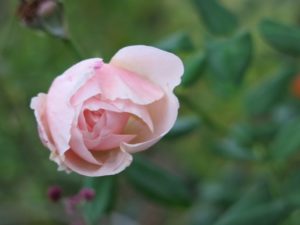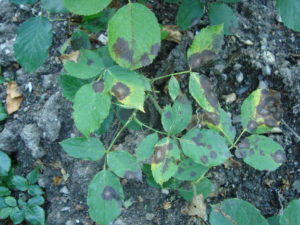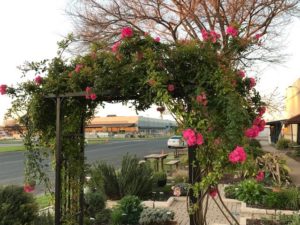
‘Heritage’ Rose
The love of roses is a subject that captivates gardeners and poets alike. Ralph Waldo Emerson wrote, “There is simply the rose; it is perfect in every moment of its existence.”
This is my fourth post on roses. I hope I’ve answered a few basic questions in order for you to have enough rose knowledge that you can either plant a new rose or help an older established one produce better sweet smelling roses.
Fertilizer Basics
Have your soil tested so that you know how much fertilizer you should be applying. Fertilizers are labeled with three numbers that represent the amount of N(itrogen), P(hospate), and K(Potassium). Read the labels and then use this tool with your soil test results to see how much you should apply. Even organic fertilizers should be labeled.
I’ve listed some common organic sources in this table:
Common Organic Sources for N, P, K |
||
| Nitrogen | Phosphate | Potassium |
|
Alfalfa Meal Blood Meal Fish Emulsion Fish Meal Seaweed Manures |
Colloidal Phosphate (Also called Rock Phosphate) Manures |
Greensand Alfalfa Meal Seaweed |
Compost is not considered a fertilizer, which is why labeling is not required. The nutrients in compost are greatly dependent on the ingredients used to create it, which can vary widely. Most compost contains some low amounts of all three, but use it to improve your soil structure or as a mulch rather than as a fertilizer. You can get your compost tested, but unless you use the exact same ingredients every time, the amounts of N, P, K will vary by batch.
No matter which fertilizer you choose, lightly rake the material into the soil, being careful not to damage the roots, and then generously water. A garden rake or hand cultivator work well. Most roses do not need any more than two feedings in early spring and late summer to encourage blooms and right after pruning. Check our gardening calendar for more information.
Diseases to Watch For

Rose leaves with black spot.
One of the more common rose diseases is Blackspot. This fungus happens during warm, wet weather. Black spots appear on the foliage, followed by yellowing and leaf drop. Plenty of sun, good air movement, and healthy soil increase plant resistance.
You will need to clean up the dropped leaves and put into trash, not the compost bin. Afterwards, you can add a small amount of compost and then mulch as this will act as a barrier between the plant and any spores in the soil. The Texas Plant Disease Diagnostic Lab has suggestions for how to treat blackspot. They recommend fungicides containing cyproconazole, triforine, or chlorothalonil among others provide good control. Additionally, there are some organic fungicides that can provide decent control of this disease such as products containing neem oil or potassium bicarbonate. Read the label and follow instructions on how to apply.
Powdery mildew appears on leaves as blistered or curled, with a haze of powdery white fungus and occurs when we have cool, dry overcast conditions while the roses are in their active growth state. Basic treatment is the same as above.
Climbing Roses

The climbing rose, ‘Peggy Martin’ in the Earth-Kind Demonstration Garden at the AgriLife Extension office on Smith Road.
If you are growing a climbing rose (and I hope you do so), in order for the rose to produce more blooms, create arches with the long canes, wrapping or braiding around a post or even mild twists as this promotes leafy growth and flowers all along the cane. This allows unlimited creativity in using climbing roses as decorations for your garden.
If you need to tie your rose canes, be sure to use a soft tie material to gently fasten such as a roll of jute twine.
Two Bloom Seasons in Central Texas
Remember here in Central Texas we have two intense bloom seasons, spring and fall, and in between we have two more or less dormant seasons of summer and winter. Winter dormancy consists of shedding foliage, stopping blooms and storing the plant’s energy in the soil-protected roots. Summer dormancy often means shedding some foliage as well as it becomes heat stressed. In order to help the rose in either dormancy to be less stressed, remember watering well at the base, and mulching to protect the soil’s moisture which also acts as a barrier of insulation. And, as a bonus, the mulch slowly breaks down and becomes even more compost for the coming season. A win – win combination for your rose!
What’s Not to Love?
There are numerous beautiful roses available at many Austin nurseries or places online like the Antique Rose Emporium. Check them out, learn about the many lovely Earth-Kind/antique roses and, if you have never grown them or previously had poor luck with roses, give them a new try. What’s NOT to love about something that has given gardeners beauty, fragrance, and grace for centuries!
Additional Resources
Best Roses for Austin and Travis County
Old Roses by Dr. William Welch
The Organic Rose Garden by Liz Druitt, Taylor Trade Publishing (April 1, 1996)
Good Bugs for Your Garden by Allison Starcher, Algonquin Books (January 5, 1995)
Plant Problems and Maintenance
Heirloom Gardening in the South by William C. Welch and Greg Grant
March Gardening Checklist for Austin and Central Texas

Carolyn Williams and her husband live and garden west of Austin in the land of limestone and caliche. This will be her 21st year as a member of Travis County Master Gardeners Association, where she has held several offices including two years as President. Carolyn has chaired numerous committees , writes articles for the TCMGA Compost Bin, gives talks to local clubs and organizations, and is a certified Landscape Designer who always enjoys discovering the beauty and rhythms of her own garden.

